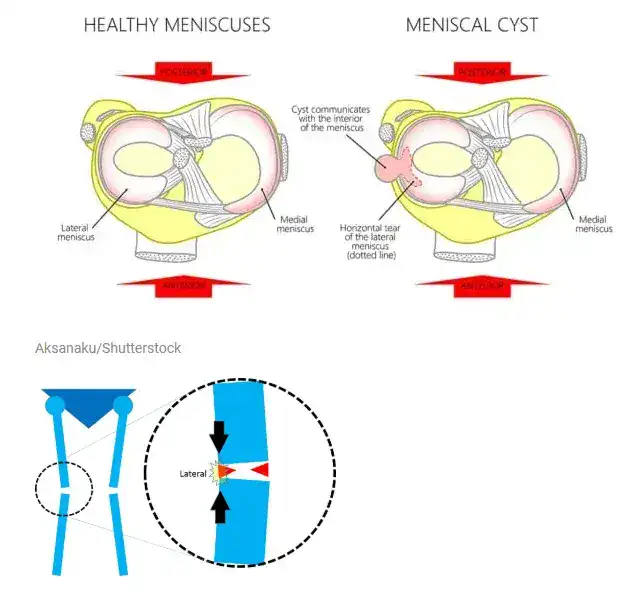Meniscal Cyst: Causes, Symptoms, and Treatment Options

Medically Reviewed By:
A meniscal cyst may gradually interfere with everyday activities. What might begin as mild knee discomfort can progress into swelling, stiffness, or a sensation of instability during movement. Tasks like climbing stairs, squatting, or sitting for extended periods may become uncomfortable or limited.
This article outlines how meniscal cysts form, the symptoms that may arise, and available treatment approaches. A clearer understanding of the condition and its impact on knee function can help individuals better evaluate care options with their physician.
What Is A Meniscal Cyst?
A meniscal cyst may develop when joint fluid escapes through a small tear in the meniscus, forming a localized pocket near the joint. This may occur alongside degenerative changes or a meniscal tear, often on the lateral side of the knee. On imaging, a meniscal cyst may appear as a small bubble by the joint line. However, its presence can indicate more extensive changes within the joint.
In some cases, meniscal cysts cause minimal discomfort and do not interfere with physical activity. In other cases, they may contribute to swelling, stiffness, or localized tenderness. While the cyst itself is not always painful, its presence may reflect underlying joint issues that could progress if not evaluated or addressed.
Understanding why a meniscal cyst forms may offer a more complete view of joint health. Focusing on the overall condition of the meniscus and surrounding structures, rather than the cyst alone, can help inform decisions related to treatment, monitoring, or activity modification.

How Does A Cyst In a Meniscus Develop?
A small tear in the meniscus often allows synovial fluid—the joint’s natural lubricant—to escape into the surrounding soft tissue, which can lead to a meniscal cyst. As this fluid accumulates, it may become trapped and form a cyst by the meniscus. This process is often linked to horizontal cleavage tears, which create a pathway for fluid to move from the joint.
Meniscal cyst formation is frequently observed in the context of joint degeneration. As the meniscus undergoes age-related or stress-related changes, its ability to recover from minor injuries may diminish. This shift in tissue balance, where breakdown occurs more rapidly than repair, can increase the likelihood of fluid accumulation and cyst development.
Knee alignment may also play a role. A valgus alignment, where the knees angle inward, places greater mechanical load on the lateral compartment of the knee. This increased pressure may accelerate lateral meniscus wear, especially in individuals with reduced tissue recovery capacity. These mechanical and biological factors can lead to meniscal tears and cyst formation.
Recognizing how these elements interact emphasizes the importance of evaluating the cyst itself, as well as the joint environment and alignment factors that may contribute to its development.
Factors That Increase The Risk Of A Meniscal Cyst
Several factors may contribute to the development of a meniscal cyst. These influences often overlap and may gradually affect the structural integrity of the knee joint over time.
- Age: Meniscal tissue loses elasticity with age, making it more vulnerable to tearing and slower to respond to stress or minor damage.
- Injuries: Injuries involving the meniscus or nearby structures may alter joint mechanics and increase the chance of fluid buildup and cyst formation.
- Repetitive stress: Activities involving frequent knee strain, such as squatting or running, can cause micro-injuries that may contribute to tissue breakdown and fluid escape.
- Osteoarthritis: Conditions like osteoarthritis may weaken the meniscus and nearby tissues, increasing the likelihood of tears and fluid accumulation near the joint.
Symptoms That May Indicate A Knee Cyst
A meniscal cyst may not always cause symptoms. When present, symptoms often reflect structural or mechanical changes within the joint.
- Weakness: Reduced knee stability or strength may occur during weight-bearing activities or movements requiring joint control.
- Limited range of motion: Knee bending or straightening may become restricted, particularly if the cyst is near a joint line.
- Swelling or stiffness: A feeling of tightness or visible swelling may occur, especially after physical activity or extended periods of inactivity.
- Firm bump on the site: A small, firm lump may be detectable near the joint line, often representing the cyst itself.
When To Seek Medical Attention
Most meniscal cysts do not require urgent care. However, certain signs may warrant further evaluation to assess underlying joint damage or prevent symptom progression.
- Persistent or worsening pain: Pain that continues or intensifies despite rest may indicate an underlying tear or degenerative joint changes.
- Visible swelling or a growing lump: An enlarging bump or swelling near the joint line may reflect fluid accumulation or increased joint pressure.
- Reduced mobility or function: Difficulty moving the knee or bearing weight may suggest mechanical impairment or progression of tissue damage.
- Mechanical symptoms: Catching, locking, or clicking sensations during movement may point to a structural tear or internal joint disruption.
Prompt evaluation by a physician in the licensed Regenexx network may help determine the cause and guide appropriate next steps, including monitoring, imaging, or treatment options.
Diagnostic Techniques Used To Confirm The Condition
Accurate diagnosis typically involves a physical exam and imaging to assess both the cyst and any related structural changes within the knee.
- Physical examination: During a physical examination, physicians may identify tenderness, swelling, limited joint movement, or a firm bump along the joint line.
- Ultrasound: Ultrasound may confirm fluid-filled structures near the meniscus and assist with real-time localization or guided aspiration when appropriate.
- Magnetic resonance imaging (MRI): MRI provides detailed soft tissue images, often identifying the cyst and any associated meniscal tears.
- X-rays: Although soft tissues are not visible, X-rays may help rule out bone changes or degenerative joint conditions.
Accurate diagnosis can help determine whether a meniscal cyst is isolated or part of a broader degenerative process requiring further consideration or intervention.
Treatment Approaches For Meniscal Cysts
Treatment varies based on symptom severity, associated meniscal damage, and joint condition. Physicians typically consider conservative options before more involved interventions.
- Anti-inflammatory medications: Physicians may recommend nonsteroidal anti-inflammatory drugs (NSAIDs) to help reduce swelling and discomfort. However, they do not address the underlying structural issue.
- Cyst aspiration: Ultrasound-guided aspiration can help temporarily remove fluid and reduce pressure around the affected area.
Regenexx’s Non-Surgical Approach to Supporting Knee Function
For individuals exploring alternatives to surgery, procedures using Regenexx lab processes are intended to potentially support joint function without removing tissue or altering the joint structure. Regenexx procedures may include:
- Platelet-rich plasma (PRP) injections: PRP is prepared from the individual’s blood and is believed to have the potential to support joint tissue health in certain musculoskeletal conditions.
- Platelet lysate (PL) Injections: PL, a refined version of PRP, contains concentrated growth factors and may be considered for targeting specific nerve-related symptoms.
- Regenexx SD injectate: This procedure uses bone marrow concentrate prepared with Regenexx lab processing with the goal of supporting joint tissue and assisting the body’s natural healing process.
All Regenexx procedures use precise image guidance to aim for greater accuracy and reduce the potential for disruption to surrounding tissues.
Explore Non-Surgical Options To Support Knee Joint Health
Age, activity level, and prior injuries can all influence joint health. While many individuals remain active into later decades, changes within the joint may go unnoticed until function becomes limited.
Even mild or intermittent symptoms can reflect underlying wear that may progress over time. Periodic evaluation, imaging, and less invasive approaches may help address joint issues early and support long-term mobility.
The Regenexx approach may offer a non-surgical option for individuals seeking to reduce discomfort and maintain function without altering the joint structure.
Get started to see if you are a Regenexx candidate
To talk one-on-one with one of our team members about how the Regenexx approach may be able to help your orthopedic pain or injury, please complete the form below and we will be in touch with you within the next business day.

Medically Reviewed By:
